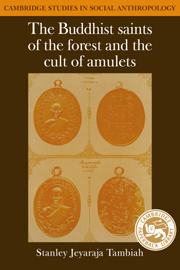Book contents
- Frontmatter
- Contents
- Acknowledgments
- Note on transcription
- 1 Introduction and manifesto
- Part I The arahant and the Path of Meditation
- Part II The hagiography of a Buddhist saint: text and context; the politics of sectarianism
- Part III The cult of amulets: the objectification and transmission of charisma
- Part IV Conceptual and theoretical clarifications
- 20 A commentary on millennial Buddhism in Thailand and Burma
- 21 The sources of charismatic leadership: Max Weber revisited
- 22 The objectification of charisma and the fetishism of objects
- Notes
- Index
- CAMBRIDGE STUDIES IN SOCIAL ANTHROPOLOGY
22 - The objectification of charisma and the fetishism of objects
Published online by Cambridge University Press: 10 December 2009
- Frontmatter
- Contents
- Acknowledgments
- Note on transcription
- 1 Introduction and manifesto
- Part I The arahant and the Path of Meditation
- Part II The hagiography of a Buddhist saint: text and context; the politics of sectarianism
- Part III The cult of amulets: the objectification and transmission of charisma
- Part IV Conceptual and theoretical clarifications
- 20 A commentary on millennial Buddhism in Thailand and Burma
- 21 The sources of charismatic leadership: Max Weber revisited
- 22 The objectification of charisma and the fetishism of objects
- Notes
- Index
- CAMBRIDGE STUDIES IN SOCIAL ANTHROPOLOGY
Summary
What indeed escaped Weber, who was so alive to the routinization and objectification of charisma in institutional structures, was the objectification of charisma in talismans, amulets, charms, regalia, palladia, and so forth – a phenomenon as old as religion, indeed as old as all forms of leadership.
In the Thai case we have examined, people attribute virtues and energies to persons because of their ascetic conduct; these saints are seen as capable of transmitting their charisma to persons directly or, more usually and lastingly, through amulets they have charged and activated. The charisma is concretized and sedimented in objects; these objects are repositories of power.
In this fetishism there are two social loops or cycles in which saint and lay public are implicated. One cycle is the ideologically developed and transparent one; the other is more hidden and manipulative and rides on the former. The first cycle is to be understood in terms of the Buddhist path of salvation: According to its cosmography, the ascetic meditator attains progressively higher spiritual levels of consciousness, leaving the grosser material excrescences behind, and through the control of his sense doors and sensory states attains understanding wisdom and universal compassion. This, then, is a state of transcendence, which also generates supranormal powers with which to affect the phenomenal world through detached action. The specifically Buddhist formulation, then, is that detached action is also pragmatically the most effective action – by being removed from the immediacy of desires and entanglements, it is all the more encompassing and creative. Now it is a part of the first cycle that these virtuoso saints are approached by merit-making laymen, to whom the amulets are distributed as part of the saints' dispensation of blessings.
- Type
- Chapter
- Information
- The Buddhist Saints of the Forest and the Cult of Amulets , pp. 335 - 347Publisher: Cambridge University PressPrint publication year: 1984
- 1
- Cited by



